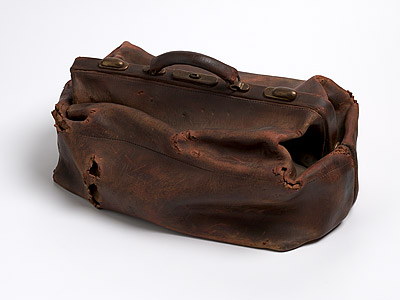Marilyn
LEVINE
Canada
1935
–
United States of America
2005
United States of America 1969
Johnston Satchel
1975
stoneware
signed and dated underneath, fibre-tipped pen, "LEVINE / 1975"
25.4 (h)
x 51.9 (w)
x 34.2 (d)
cm
Purchased 1975
National Gallery of Australia, Canberra
NGA 1975.657
The work of Marilyn Levine is characterised by inordinate attention to detail which creates an uncanny illusion of reality. At first glance, Johnston satchel appears much like any other lovingly dilapidated leather bag. Only upon closer inspection is the object’s true material revealed. The stained and partially glazed ceramic is modelled by hand, without assistance of casting techniques. The artist has captured in stoneware the scuffs and abrasions caused to an object by recurrent and customary use. Levine sculpts with a clay and nylon composite to achieve her trademark verisimilitude, staining her finished objects with commercial glazes that allow expanded colour possibilities.
In 1969 Levine moved to the West Coast of the USA, embracing its vibrant art scene. Here she was introduced to California Funk, an emerging ceramics movement inspired by Pop art, which held at its core the exaggerated representation of daily life. Levine began to explore the deceptively realistic visual language with which she would work for the next 30 years: ‘It was in the process of trying out being a funk artist, trying to be funky, that I found out what you could do with a pair of shoes or what you could do with a jacket…’[1] Themes of absence and loss implicitly inform the artist’s aesthetic, with her work representing human existence and the passage of time. Levine’s meticulous trompe l’oeil style encourages viewers to examine Johnston satchel for its form, texture and presence in reality, rather than any perceived functionality.
Lisa McDonald
International Art
National Gallery of Australia, Canberra
[1] Oral history interview with Marilyn Levine, 15 May 2002, Archives of American Art, Smithsonian Institution

